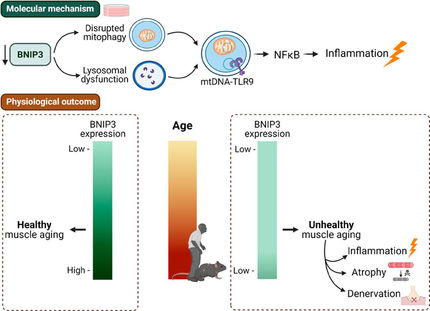New active substances against muscle atrophy being researched
Advertisement
With increasing age or due to illness, physical performance can decline sharply. For those affected, this often means a loss of quality of life and independence. In his cooperative doctorate at the University of Cologne and the Technical University of Cologne, Stefan Peters has therefore been researching new active substances to combat muscle atrophy. In the process, he has produced and tested 67 new substances. In initial experiments, the most effective of these substances is 50 times more active than the underlying reference compounds.
"In the wake of demographic change, complex signs of aging such as physical frailty are steadily increasing. More than ten percent of people over 60 are affected by sarcopenia, i.e. age-related muscle loss. Since the disease occurs in the home environment, progresses insidiously and varies from person to person, a high number of unreported cases can be assumed. In addition, there are cases of cachexia. Muscle wasting is caused by diseases such as cancer, chronic heart failure or chronic inflammation," says Peters. The consequences are often immense. Muscle degeneration, for example, can lead to physical weakness, balance problems, limited mobility and an increased risk of falling.
So far, there are no drugs without serious hormonal side effects that can be used to treat muscle atrophy, says Peters: "One therapy currently involves mobilizing patients* through physiotherapy and increased exercise, as well as a change in diet." However, since these measures can only help to a limited extent, the need for new active substances is high, he said.
Myostatin as a key regulator of muscle growth
In his doctoral thesis, Peters worked on the synthesis of substances designed to inhibit the protein myostatin. "Myostatin is produced in the human body and limits muscle growth. It ensures that muscles are not formed in an uncontrolled manner and that the body is therefore not overloaded. This is especially crucial during the body's development to maintain a balance between buildup and excessive growth." In certain cases of muscle degeneration, however, it can be inhibited in a controlled manner without serious consequences for the organism, he said.
"Various studies have shown that in sarcopenia and cachexia, myostatin is produced more in the body. So there is potential here to address this set screw with an active ingredient," Peters says. In some neuromuscular degenerative diseases such as muscular dystrophy, on the other hand, a reduced myostatin level has been found. This, he says, shows that the body is responding naturally to muscle degeneration. "An agent that additionally inhibits myostatin is not useful here - the body has already turned this adjusting screw itself."
A total of 67 new compounds created and tested
The starting points for the synthesis were two existing reference compounds that target myostatin and another molecule related to myostatin, respectively. "These compounds are so-called drug candidates. This means that these substances are still being researched, but their structure and effect have already been scientifically characterized," Peters explains.
He first optimized these compounds theoretically with the help of a substance library and computer-assisted methods. "To do this, I exchanged components and analyzed the influence of these adjustments on the substance effects. In this way, structure-activity relationships can be traced and substances with the desired properties can be produced in a targeted manner," says Peters.
The PhD project produced a total of 67 promising substances, which Peters tested in a further step together with postdoc Dr. Viktoria Marquardt from Prof. Dr. Sherif El Sheikh's research group. "To do this, we added the substances to a cell culture treated with myostatin and then detected their effect," Peters said.
Important contribution to basic research
"The tests were informative in many respects: we were able to exclude many compounds with small effects and at the same time identify five that were particularly active and thus potentially promising. The compound with the greatest effect was 50 times more active than the reference compounds," says Peters. The results of his work are an important contribution to basic research, he adds: "By synthesizing and testing new compounds, deeper conclusions can be drawn about structure-activity relationships. Based on this, the most promising compounds created in my work can now be further optimized in additional research."
For example, the substances developed by Peters are to be further researched at TH Köln, as Prof. Dr. Sherif El Sheikh from the Faculty of Applied Natural Sciences explains: "In a next step, the substances are to be tested on real muscle cells and fibers to check whether a positive effect on muscle growth can be observed. This will be done in cooperation with the German Aerospace Center in Cologne, where it will also be possible to check whether the substances can counteract muscle degradation in weightlessness, i.e. in space travel."
Note: This article has been translated using a computer system without human intervention. LUMITOS offers these automatic translations to present a wider range of current news. Since this article has been translated with automatic translation, it is possible that it contains errors in vocabulary, syntax or grammar. The original article in German can be found here.

















































